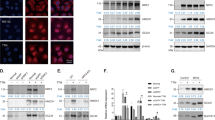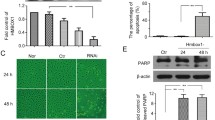Abstract
Copper egress is an essential regulator of the kinetics of cellular copper and is primarily regulated by ATP7A, a copper-transporting P-type ATPase. However, little is known under which physiological condition copper egress is induced and its molecular consequence. In current manuscript, using THP-1 cells, a human monocytic cell line, we found that ATP7A expression was increased in cells exposed to phorbol-12-myristate-13-acetate (PMA), a potent inducer of neovascularization and cancer. Inductively coupled plasma mass spectrometry revealed that PMA also induced copper egress. Inhibition of ATP7A expression using small interfering RNA abrogated PMA induced copper egress. PMA treatment in THP-1 cells resulted in increased expression of matrix metalloproteinase (MMP) 9 and vascular endothelial growth factor receptor 1 (VEGFR1), whereas inhibition of ATP7A resulted in suppression of PMA-induced expression of VEGFR1, but not MMP9. Finally, addition of exogenous copper into the conditioned medium did not change VEGFR1 expression in THP-1 cells. Collectively, we demonstrate that PMA induces copper egress in THP-1 cells, which is regulated by ATP7A, and ATP7A regulates VEGFR1 expression. Considering the involvement of copper in neovascularization, our current finding provides the potential evidence to interpret the molecular mechanism.






Similar content being viewed by others
Abbreviations
- ICP-MS:
-
Inductively coupled plasma mass spectrometry
- MMP:
-
Matrix metalloproteinase
- PMA:
-
Phorbol-12-myristate-13-acetate
- VEGF:
-
Vascular endothelial growth factor
- VEGFR1:
-
VEGF receptor 1
References
Akuzawa N, Kurabayashi M et al (2000) Zinc finger transcription factor Egr-1 activates Flt-1 gene expression in THP-1 cells on induction for macrophage differentiation. Arterioscler Thromb Vasc Biol 20(2):377–384
Armendariz AD, Gonzalez M et al (2004) Gene expression profiling in chronic copper overload reveals upregulation of Prnp and App. Physiol Genomics 20(1):45–54. doi:10.1152/physiolgenomics.00196.2003
Bellingham SA, Lahiri DK et al (2004) Copper depletion down-regulates expression of the Alzheimer’s disease amyloid-beta precursor protein gene. J Biol Chem 279(19):20378–20386. doi:10.1074/jbc.M400805200
Clauss M, Weich H et al (1996) The vascular endothelial growth factor receptor Flt-1 mediates biological activities. Implications for a functional role of placenta growth factor in monocyte activation and chemotaxis. J Biol Chem 271(30):17629–17634. doi:10.1074/jbc.271.30.17629
Cursiefen C, Chen L et al (2004) VEGF-A stimulates lymphangiogenesis and hemangiogenesis in inflammatory neovascularization via macrophage recruitment. J Clin Invest 113(7):1040–1050
de Vries C, Escobedo JA et al (1992) The fms-like tyrosine kinase, a receptor for vascular endothelial growth factor. Science 255(5047):989–991. doi:10.1126/science.1312256
Fan F, Wey JS et al (2005) Expression and function of vascular endothelial growth factor receptor-1 on human colorectal cancer cells. Oncogene 24(16):2647–2653. doi:10.1038/sj.onc.1208246
Finney L, Mandava S et al (2007) X-ray fluorescence microscopy reveals large-scale relocalization and extracellular translocation of cellular copper during angiogenesis. Proc Natl Acad Sci USA 104(7):2247–2252. doi:10.1073/pnas.0607238104
Goodman VL, Brewer GJ et al (2004) Copper deficiency as an anti-cancer strategy. Endocr Relat Cancer 11(2):255–263. doi:10.1677/erc.0.0110255
Gu YH, Kodama H et al (2001) ATP7A gene mutations in 16 patients with Menkes disease and a patient with occipital horn syndrome. Am J Med Genet 99(3):217–222. doi:10.1002/1096-8628(2001)9999:9999<::AID-AJMG1167>3.0.CO;2-R
Hiratsuka S, Minowa O et al (1998) Flt-1 lacking the tyrosine kinase domain is sufficient for normal development and angiogenesis in mice. Proc Natl Acad Sci USA 95(16):9349–9354. doi:10.1073/pnas.95.16.9349
La Fontaine S, Mercer JF (2007) Trafficking of the copper-ATPases, ATP7A and ATP7B: role in copper homeostasis. Arch Biochem Biophys 463(2):149–167. doi:10.1016/j.abb.2007.04.021
Lutsenko S, Barnes NL et al (2007) Function and regulation of human copper-transporting ATPases. Physiol Rev 87(3):1011–1046. doi:10.1152/physrev.00004.2006
Luttun A, Tjwa M et al (2002) Revascularization of ischemic tissues by PlGF treatment, and inhibition of tumor angiogenesis, arthritis and atherosclerosis by anti-Flt1. Nat Med 8(8):831–840
Montesano R, Orci L (1985) Tumor-promoting phorbol esters induce angiogenesis in vitro. Cell 42(2):469–477. doi:10.1016/0092-8674(85)90104-7
Murakami M, Zheng Y et al (2008) VEGFR1 tyrosine kinase signaling promotes lymphangiogenesis as well as angiogenesis indirectly via macrophage recruitment. Arterioscler Thromb Vasc Biol 28(4):658–664. doi:10.1161/ATVBAHA.107.150433
Qin Z, Itoh S et al (2006) Essential role for the Menkes ATPase in activation of extracellular superoxide dismutase: implication for vascular oxidative stress. FASEB J 20(2):334–336
Qin Z, Gongora MC et al (2008) Role of Menkes ATPase in angiotensin II-induced hypertension: a key modulator for extracellular superoxide dismutase function. Hypertension 52(5):945–951
Raju KS, Alessandri G et al (1982) Ceruloplasmin, copper ions, and angiogenesis. J Natl Cancer Inst 69(5):1183–1188
Sawano A, Iwai S et al (2001) Flt-1, vascular endothelial growth factor receptor 1, is a novel cell surface marker for the lineage of monocyte-macrophages in humans. Blood 97(3):785–791. doi:10.1182/blood.V97.3.785
Schaefer M, Gitlin JD (1999) Genetic disorders of membrane transport. IV. Wilson’s disease and Menkes disease. Am J Physiol 276(2 Pt 1):G311–G314
Taylor CJ, Motamed K et al (2006) Protein kinase C and downstream signaling pathways in a three-dimensional model of phorbol ester-induced angiogenesis. Angiogenesis 9(2):39–51. doi:10.1007/s10456-006-9028-y
Tuomisto TT, Riekkinen MS et al (2005) Analysis of gene and protein expression during monocyte-macrophage differentiation and cholesterol loading–cDNA and protein array study. Atherosclerosis 180(2):283–291. doi:10.1016/j.atherosclerosis.2004.12.023
Wey JS, Fan F et al (2005) Vascular endothelial growth factor receptor-1 promotes migration and invasion in pancreatic carcinoma cell lines. Cancer 104(2):427–438. doi:10.1002/cncr.21145
Worley JR, Baugh MD et al (2003) Metalloproteinase expression in PMA-stimulated THP-1 cells. Effects of peroxisome proliferator-activated receptor-gamma (PPAR gamma) agonists and 9-cis-retinoic acid. J Biol Chem 278(51):51340–51346. doi:10.1074/jbc.M310865200
Yang AD, Camp ER et al (2006) Vascular endothelial growth factor receptor-1 activation mediates epithelial to mesenchymal transition in human pancreatic carcinoma cells. Cancer Res 66(1):46–51. doi:10.1158/0008-5472.CAN-05-3086
Ziche M, Jones J et al (1982) Role of prostaglandin E1 and copper in angiogenesis. J Natl Cancer Inst 69(2):475–482
Acknowledgments
This work was supported by a National Scientist Development Grant (0835268N) from the American Heart Association, and a URC Faculty Development Award from the University of Cincinnati. We thank Dr. Tohru Fukai (University of Illinois at Chicago) for his helpful discussion.
Author information
Authors and Affiliations
Corresponding author
Rights and permissions
About this article
Cite this article
Afton, S.E., Caruso, J.A., Britigan, B.E. et al. Copper egress is induced by PMA in human THP-1 monocytic cell line. Biometals 22, 531–539 (2009). https://doi.org/10.1007/s10534-009-9210-y
Received:
Accepted:
Published:
Issue Date:
DOI: https://doi.org/10.1007/s10534-009-9210-y




